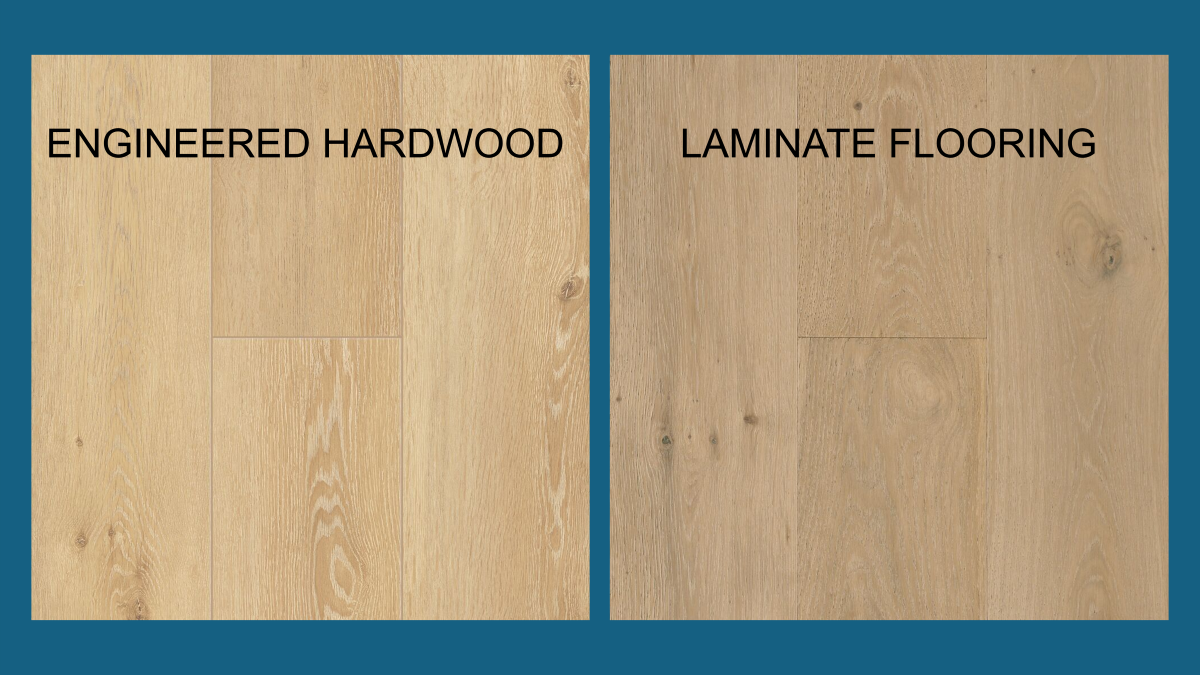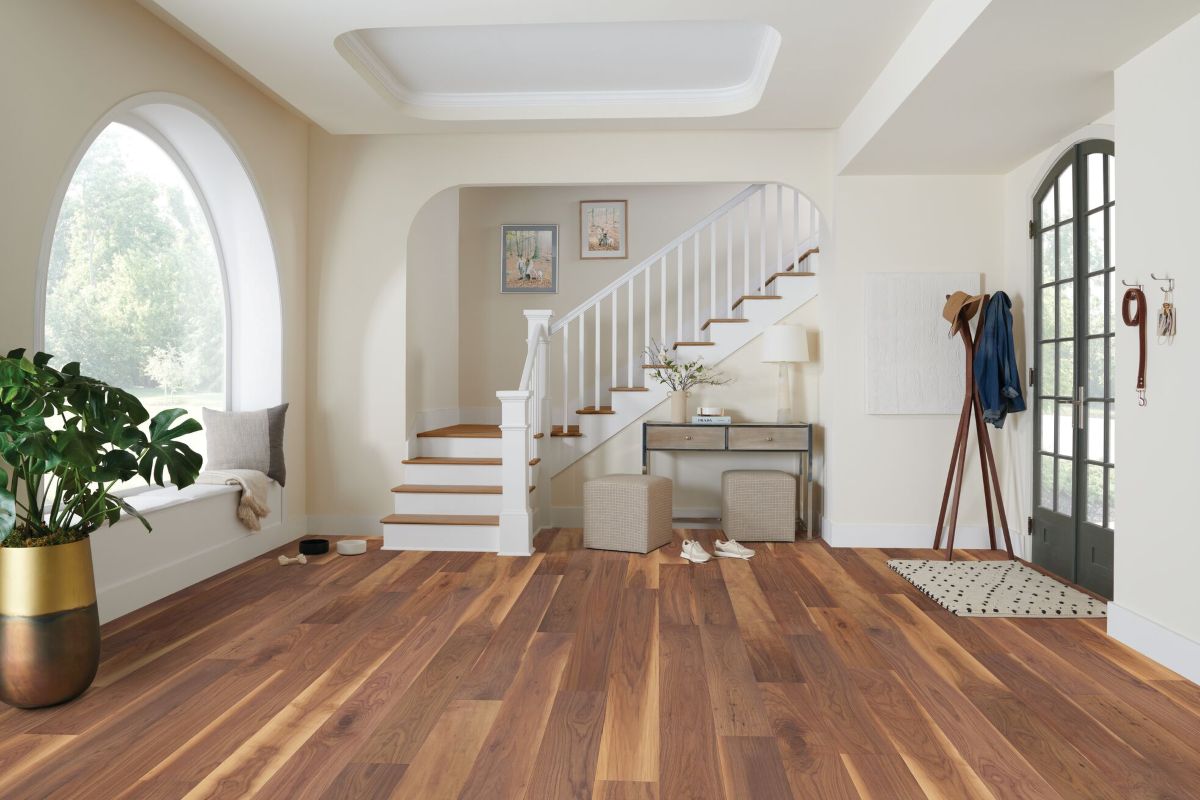Engineered Hardwood Flooring vs Laminate
By Robbins Flooring Expert, Published August 21, 2025
If you’re weighing new flooring options, consider two contenders: engineered hardwood flooring versus laminate. Both give you the warm, classic look of natural wood. However, their construction varies considerably. And that makes a significant difference, especially when considering daily use, cost, maintenance, and long-term value.
This guide will help you understand the benefits of laminate flooring and engineered wood flooring. The aim is to help you determine which best suits each room in your home.

Construction: What’s Under the Hood
To understand the performance characteristics of these two flooring options, it is helpful first to understand their construction.
Engineered Hardwood Flooring
Engineered hardwood flooring is real wood. Its top layer—known as the wear layer—is genuine hardwood. It sits over several layers of plywood or high-density fiberboard (HDF). This layered construction adds strength and stability, particularly in areas where solid hardwood flooring might warp from moisture.
Considering the top veneer is real hardwood, engineered wood offers the authentic look and feel of solid wood flooring. At the same time, engineered hardwood affords better adaptability to various environments.
Laminate Flooring
Laminate flooring is entirely synthetic. It consists of a core (usually fiberboard), topped with a high-resolution image of wood. The surface includes a durable wear layer for enhanced scratch and dent resistance. Some options feature water-resistant or waterproof properties, making them ideal for bathrooms, kitchens, and basements.
For example, Robbins® offers Valley Terrain™ and Pacific Path™ laminate flooring. Both are 100% waterproof, backed by a limited lifetime waterproof warranty.
If genuine wood flooring is your goal, be fully aware that laminate doesn’t use any real hardwood in its construction. But thanks to modern printing technology, it can closely resemble the real thing.
Appearance: Realism and Style
Again, if authentic-looking hardwood floors are your aim, both options deliver—but in different ways.
- Engineered wood flooring features a real wood top layer, making every plank unique in grain, knots, and texture. You’ll see (and feel) the character of natural wood throughout.
- Laminate flooring replicates the look of wood with a printed image. It looks great from a distance, but up close, you might notice repeating patterns or a lack of depth.
Want something hand-scraped or wire-brushed? You’ll find more texture and variation in engineered hardwood flooring. But laminate has come a long way. It captures the look of oak, maple, hickory, and more, mimicking solid wood flooring with remarkable accuracy.
Which Flooring Handles Daily Wear and Tear Better?
Your floor needs to handle wear and tear from kids, pets, and everyday life. Here’s how each type stacks up.

Laminate Flooring
Laminate’s wear layer is built for battle. The flooring is highly resistant to scratches, stains, and dents. That makes it a solid choice for high-traffic areas, such as entryways, hallways, and playrooms. If you’ve got pets or active kids, laminate flooring might be your MVP.
Many styles are also waterproof or water-resistant, depending on the construction. That’s a massive win for bathrooms or mudrooms.

Engineered Hardwood Flooring
While engineered wood flooring is more scratch-resistant than solid hardwood flooring, it’s still real wood, and real wood can scratch. That said, advanced finishes and options, such as densified wood, can significantly increase resistance.
For example, Robbins has an innovative densified wood floor called ArmorWood™. The flooring is real hardwood, only better because it has been substantially hardened. ArmorWood offers four times more scratch resistance and six times more dent resistance than traditional engineered wood flooring. As an added plus, the flooring is also waterproof.
Engineered hardwood has one significant advantage over laminate flooring. You can refinish it, provided the top wear layer is sufficiently thick. When a laminate floor wears out, you must replace it. An engineered hardwood floor, however, lets you extend its life far beyond that of laminate.
How Difficult is the Installation of Engineered Hardwood vs. Laminate?
Well, that comes down to how handy you are.
Installing Laminate Flooring
Laminate flooring installs quickly and easily. Most use a tongue-and-groove locking system, which means you can install laminate floors as a floating floor—no nails or glue required. That’s why it’s a top pick for DIYers who want fast results without specialized tools.
Installing Engineered Hardwood Flooring
Some engineered options also use tongue-and-groove or click-lock systems. So yes, you can install engineered wood as a floating floor. However, some may require glue or staples, especially for more permanent applications. That makes them better suited for professional installation unless you’re particularly handy.
Cost: Short-Term Spend vs. Long-Term Value
Flooring is a long-term investment, but price still matters—especially if you’re renovating an entire home.
- Laminate flooring tends to be more cost-effective, ranging from $1 to $3 per square foot, with lower installation costs. Laminate is an ideal choice if you’re trying to refresh a space on a tight budget.
- Engineered hardwood flooring typically starts at around $3 per square foot and can increase to $10 or more per square foot. Installation costs are also higher.
However, as mentioned, engineered wood flooring can outlast laminate. That long-term durability may justify the higher upfront cost.
Choosing Between Engineered Wood Flooring and Laminate
Both offer realistic wood looks, with engineered hardwood including a real wood top layer. Both offer some level of performance against water. Both have scratch resistance built in.
So, which best suits your application?
Choose Laminate Flooring if:
- You want something affordable, durable, and easy to maintain
- You’re updating high-traffic areas or moisture-prone rooms
- You plan to install the floors yourself
- You love the benefits of laminate flooring, like waterproofing and impact resistance
Choose Engineered Hardwood Flooring if:
- You want the authentic beauty of real wood
- You’re willing to invest more upfront for a longer lifespan and refinishing potential
- You want flooring that adds long-term value and style
- You’re looking to mimic the look of solid hardwood flooring in areas where solid wood wouldn’t hold up
Robbins® Floors: Where Performance Meets Style
Robbins delivers flooring features that fit real-life needs.
For flooring that can handle anything your family throws at it, we have you covered with engineered hardwood, laminate, porcelain tile, rigid core, and hybrid resilient options.
Each option has different performance features. But each provides a flooring solution that will last for decades, with many offering a lifetime warranty.
Find your perfect floor today—and feel good about every room in your home. Find the Robbins retailer nearest you.
